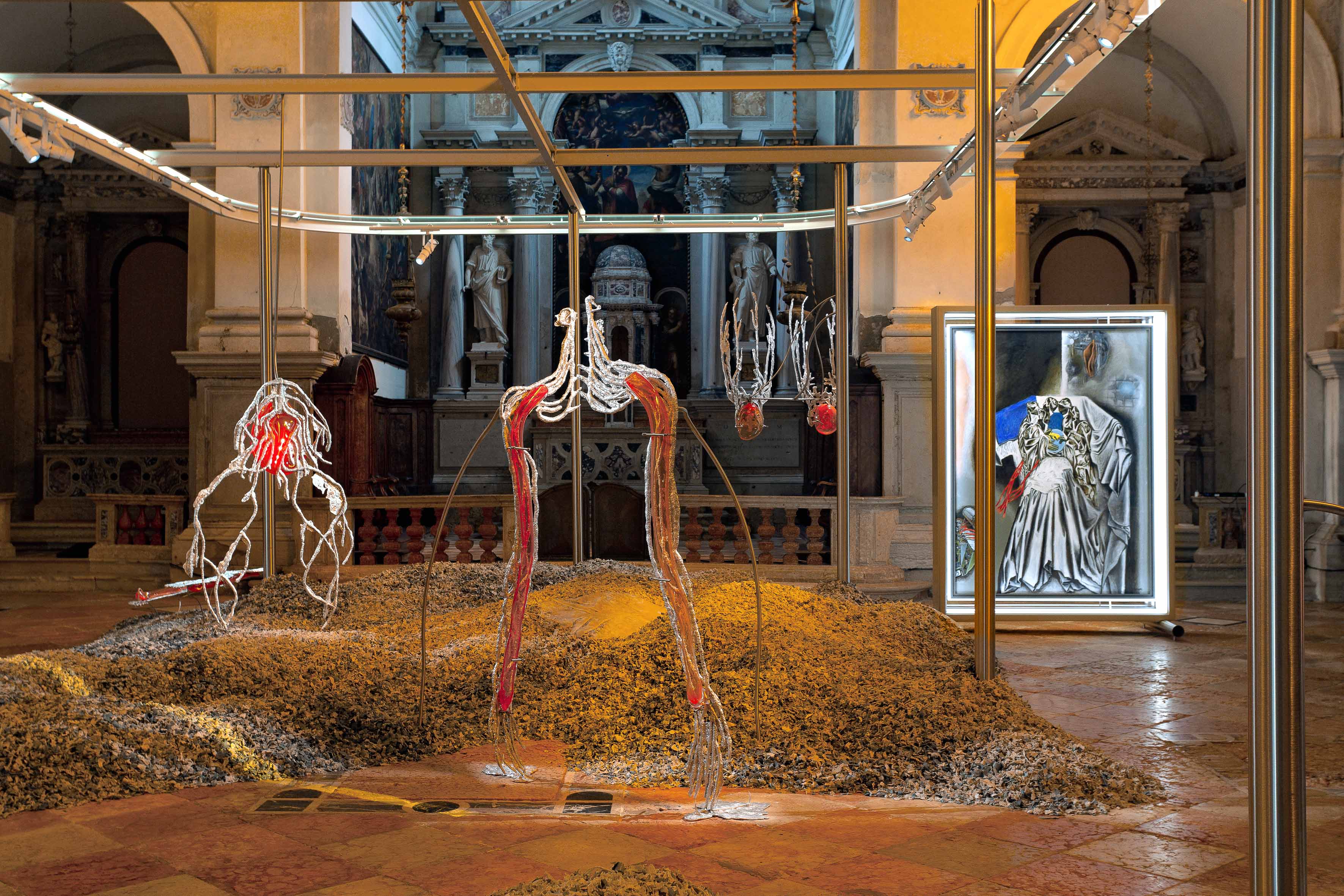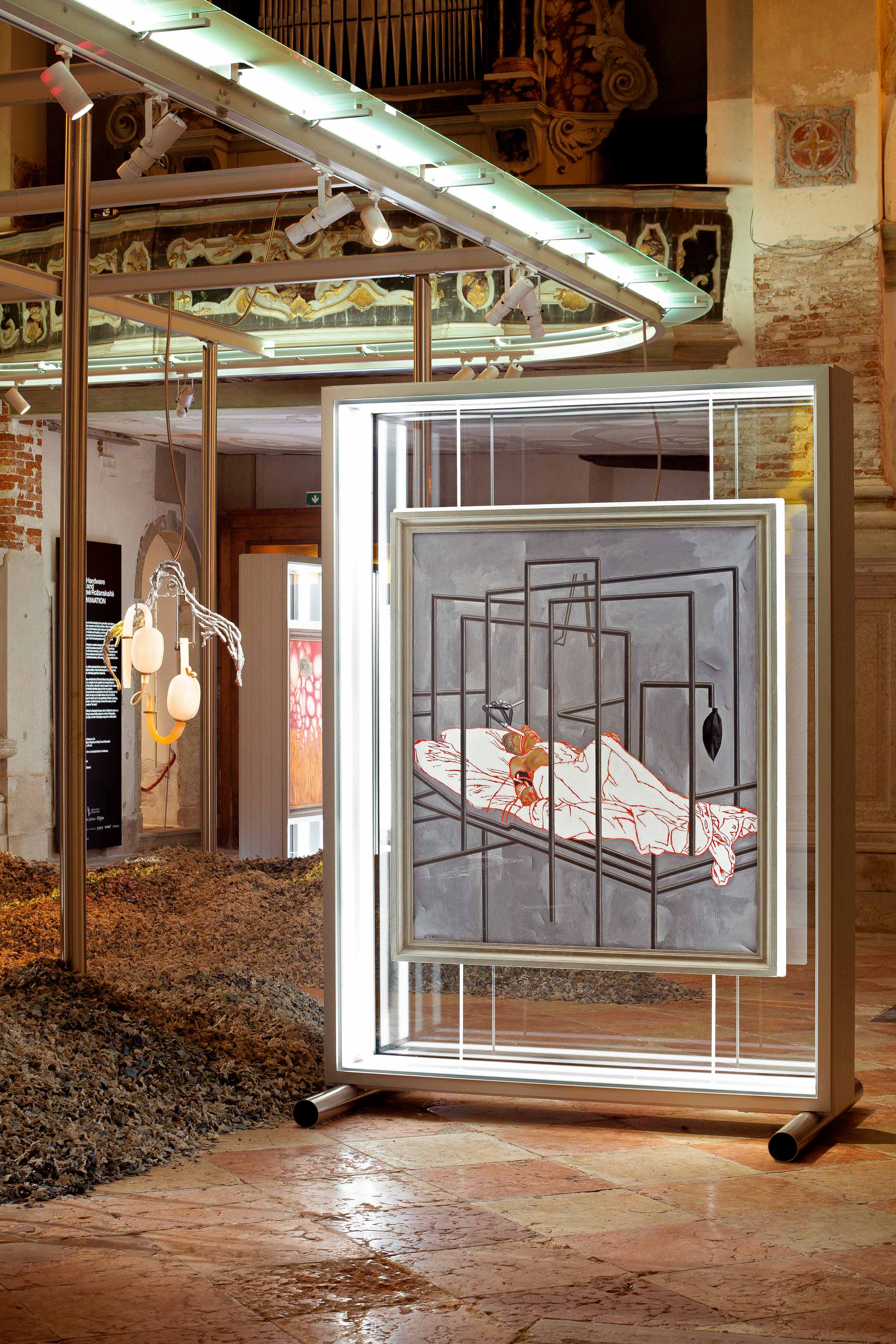YYYYMMDD >>> BACK HOME <<< >>> SELECTED FEATURES <<< >>> INTERVIEWS <<<
[20240604]
INFLAMMATION by PAKUI HARDWARE [NERINGA ČERNIAUSKAITĖ and UGNIUS GELGUDA] and MARIJA TERESĖ ROŽANSKAITĖ at LITHUANIAN PAVILION at VENICE BIENNALE curated by VALENTINAS KLIMAŠAUSKAS and JOÃO LAIA [from 20240416 to 20241030]
[Photos: Ugnius Gelguda]























The Pavilion of Lithuania at the 60th International Art Exhibition – La Biennale di Venezia presents Inflammation, an installation by artist duo Pakui Hardware (Neringa Černiauskaitė and Ugnius Gelguda) that features paintings by Marija Teresė Rožanskaitė (1933–2007), curated by Valentinas Klimašauskas and João Laia. The installation features landscape and architecture of the environment by Petras Išora and Ona Lozuraitytė and is staged in the Chiesa di Sant’Antonin.
Inflammation brings together two artistic practices belonging to different generations and explores the inflammation of (post)human bodies under today’s economic and social conditions. Marija Teresė Rožanskaitė’s paintings and a sculptural installation by Pakui Hardware (in collaboration with Išora x Lozuraitytė Studio) connect via their exploration of questions related to medicine and health, as well as natural, cosmic, and industrial landscapes. The combined presentation conveys the interconnectedness of bodies and environments in crisis while offering a metabolic balance, helping to cool the burning human and planetary bodies.
The fused aluminum and glass sculptures by Pakui Hardware resemble enlarged nervous systems with pulsating hot spots of inflammation. Like bodies, they come to life when touched by a burning beam that resembles spatial or organ scanning. The prosthetic motif—using silicone membranes and medical or laboratory materials—is further expanded by the way the distinct elements merge into a larger unified installation, a techno-organism.
In Rožanskaitė’s paintings, unnamed diseases, sterile operating theaters and medical consultation rooms, visceral-themed assemblages, and machine-like objects radiate chronic inflammations of the cosmic flesh.
The project draws direct inspiration from Marya Rupa and Raj Patel’s 2021 book Inflamed: Deep Medicine and the Anatomy of Injustice, which employs inflammation as a metaphor for the systemic harm inflicted on humanity and the planet. Inflammation, according to the authors, is the body’s normal response to toxic conditions, and rather than targeting individual unhealthy organs, treatment should begin by addressing the very systems—economic and social—that cause chronic ailments to be passed from one generation to the next.
The book and the exhibition connect the human and the planetary scales. Not only are our bodies aflame, but so is the Earth. Another critical thread, which has also been evolving in the artists’ work, is the questioning of Western cosmology, characterized by constant divides and separations, between mind and body and between human and nature, of what is considered our own and what belongs to the realm of the other. In this delirious post-landscape, it is difficult to distinguish between what might be attributed to nature and what could be a human creation. Objects referring to human bodily systems in a state of inflammation are set in an architectural post-natural landscape of hybrid soil, light, and technology, all merging into a unified hybrid techno-organism.
For this year’s edition, the commissioner and the curators chose the iconic Chiesa di Sant’Antonin, a church that has never hosted a national pavilion before. The church, traditionally a site of faith, community, and transcendence, is transformed into a liminal space. Pakui Hardware’s contemporary installation and the modern figurative paintings by Rožanskaitė meet in the historic hall to create an immersive landscape, gesturing towards a future of potential healing.
A catalogue accompanying the exhibition is published by Mousse Publishing and the Lithuanian National Museum of Art with texts by Arūnas Gelūnas, Estelle Hoy, Petras Išora and Ona Lozuraitytė, Valentinas Klimašauskas, Inga Lāce, and João Laia.
The Lithuanian National Museum of Art is one of the largest national art museums in Lithuania with the aim of building, safekeeping, researching, conserving, restoring, curating, and exhibiting the collections of the arts and cultural artifacts of national significance at its nine divisions in Vilnius, Klaipėda, Palanga, and Juodkrantė.
Producer of the exhibition: Lithuanian National Museum of Art
Artists: Pakui Hardware (Neringa Černiauskaitė, Ugnius Gelguda) and Marija Teresė Rožanskaitė
Curators of the pavilion: Valentinas Klimašauskas, Joao Laia
Commissioner of the pavilion: Arūnas Gelūnas
Exhibition environment and landscape architects: Išora x Lozuraitytė Studio for Architecture
Light artist: Eugenijus Sabaliauskas
Design: Vytautas Volbekas
Coordinators: Evaldas Stankevičius, Egla Mikalajūnė
Architect coordinator: Eglė Jagminė
Public relations‘ producer: Rūta Statulevičūtė-Kaučikienė
Commissioned by: Lietuvos Respublikos kultūros ministerija
Financed by: Lietuvos kultūros taryba
Pakui Hardware is a duo founded in 2014 by Neringa Černiauskaitė and Ugnius Gelguda, devoted to exploring relationships between the body, technology, and economy. It has had solo exhibitions at the Baltic Centre for Contemporary Art, Gateshead, UK; mumok, Vienna; the Museum der bildenden Künste, Leipzig, Germany; the Lithuanian National Museum of Art, Vilnius; Kunstverein Bielefeld, Germany; carlier | gebauer (Berlin / Madrid); Tenderpixel, London; the Contemporary Art Centre, Vilnius; Kim? Contemporary Art Centre, Riga; and Polansky, Prague, among others. Pakui Hardware participated in the 16th Istanbul Biennial; the Baltic Triennial 13, Vilnius; Biennale Gherdëina, Italy; and the Kaunas Biennial, Lithuania, as well as in group exhibitions at Kunsthalle Basel, Switzerland; MAXXI, Rome; the National Gallery, Prague; the Taipei Fine Arts Museum, Taiwan; CAPC Musée d’art Contemporain de Bordeaux, France; MO.CO., Montpellier, France; MS2 Muzeum Sztuki, Łódź, Poland; the National Gallery of Art, Vilnius; Ujazdowski Castle Centre for Contemporary Art, Warsaw; and Bozar, Brussels, among many other venues.
Marija Teresė Rožanskaitė (1933–2007) was a Lithuanian artist famous for her bold work and remarkable life story. Having survived her father’s execution, her own deportation to Siberia, and starvation, she returned to Lithuania in 1947 together with her mother. However, it was not until 1953, with Joseph Stalin’s death and a slight easing of repressions, that Rožanskaitė dared to enrol in the State Art Institute of Lithuania. The artist’s work was rarely seen in exhibition spaces, and she faced challenges adapting to the Soviet system and the local art community – her assemblages, collages, and nature installations broke the official standards of Soviet art. Nevertheless, Rožanskaitė taught at the Vilnius Justinas Vienožinskis Art School for thirty years. Her own work gained more serious recognition posthumously. Larger solo exhibitions have been held at the Contemporary Art Centre, Vilnius (2003, curated by Jonas Valatkevičius) and the National Gallery of Art, Vilnius (2013, curated by Laima Kreivytė). Recently her work was also presented in the group exhibitions The Endless Frontier, Baltic Triennial 14, CAC Vilnius (2021, curated by Valentinas Klimašauskas and João Laia) and Unframed: Leis, Tabaka, Rožanskaitė, Kumu Art Museum, Tallinn, Estonia (2023, curated by Anu Allas and Laima Kreivytė).
[Text: Valentinas Klimašauskas and Joao Laia]
©YYYYMMDD All content and design by Daniela Grabosch + Ricardo Almeida Roque unless otherwise stated. Images, Videos and Texts can only be used under permission of the author(s).